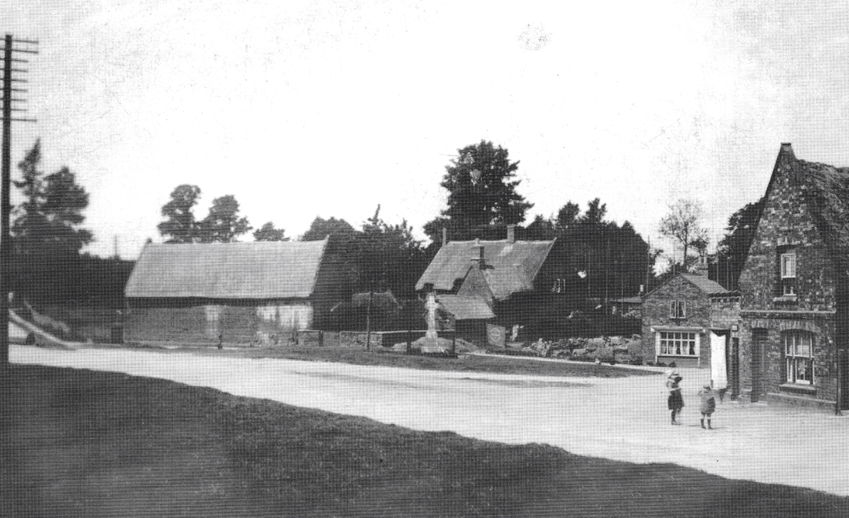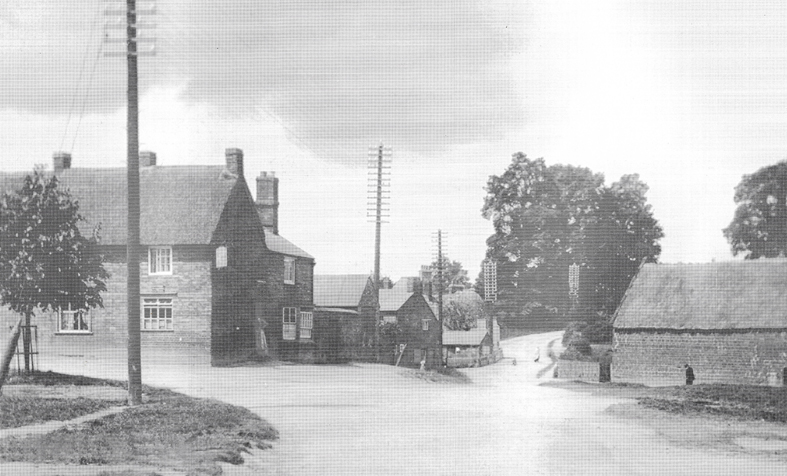The Jubilee Hall used to stand just behind the memorial green, on the opposite side of the road to where the Butchers and Patisserie are today. It was a stone barn with a thatched roof and was used as a meeting place for clubs and events much as the village hall is used today .
It was an ancient building, possibly built in the late 1600’s at the same time as ‘The Springs’, the thatched stone house which still stands today just behind the site of the Jubilee Hall. In the late 1800’s and early 1900’s the house and barn were occupied by a family called Smith who ran a laundry there. Bob Browning who was born in 1892 recalled the laundry but we don’t know for sure whether it was run from the house or the barn.
The name Jubilee Hall is believed to have originated from Queen Victoria’s Jubilee, probably her Diamond Jubilee of 1897. It may be that this was when the barn began to be used as a meeting place rather than as a laundry.
In 1914 the house and barn which had been owned by the Church were bought by the Ward family The Jubilee Hall continued to be used as a meeting place until around the time of the second world war, and we have several local memories of it from the 1920’s and 1930’s.
The Jubilee Hall

Photo lent by Janet Randall
This photograph, lent by Janet Randall, was taken in 1920. n the far right is the old Post Office. To the left of this can be seen the scaffolding from the building of the New School House. In the centre of the picture is the thatched house known as ‘The Springs’, and in front of this is the war memorial. Note the size of the oak tree beside it. The building on the left is the Jubilee Hall.
Memories of the Jubilee Hall
In March 1981 there was an article published in the Prattler, written by Marjorie Hamborg, based on information from Mr and Mrs Amos Lee, which gives a good insight into its use. This article is reprinted here in italics but we have also added some additional information based on the recollections of a number of other local people.
From The Prattler March 1981
“Our readers may have noticed that to the left of the thatched cottage facing the Memorial Green there is an old wall built of Northamptonshire stone. As this is now being reshaped to camouflage the building of a garage, I thought it would be of interest to know a bit about the history of this part of Heyford. So I visited my friends Mr and Mrs Amos Lee in Furnace Lane as they can give us new villagers some of the history of the Jubilee Hall that used to stand on this site.
At one time this was the only place where the young folk could gather, and here they came to play darts, skittles, rings, bagatelle, and a bit of boxing.”
It was also used for private parties. Dorothy Kingston had her Wedding reception there and Tommy Rolfe of the Foresters supplied them with a ham for £1.
The Pussyfoot Club
“The hall was mainly used by the men of the village, was teetotal, and was given the name ‘Pussyfoot Club’. The ladies of the village were invited when a dance was held there. Mrs Dorothy Kingston remembers them well, the fiddle being played by Lily Porch and Bern Kingston, and the piano by Lily’s sister Phillis. I also understand that Mrs Cameron from the school also used to take part. There was a small stove around which wet clothes could be dried in bad weather.”
Bob Browning who was born in 1892 recalled that ‘it was open six evenings a week between 6 pm and 10 pm. You could buy drinks there and play skittles. Sometimes there was also boxing, done in those days with bare fists.’
Bill Nickolls also remembers the Pussyfoot Club. The youngsters came from 5 pm to 8 pm. They paid a halfpenny per night to play darts, billiards, skittles and cards. Later the older ones came. They took it in turns to run the bar. Bill remembers on one occasion how somebody put a firework in the keyhole. The door jammed and they had to escape through the toilet window by climbing on the bucket.
Bill Kingston remembers the dances on Saturday nights. His father Bernard, and Lily Porch (later Mrs Green) played the violin. They danced waltzes, the military two-step and the lancers (a formation dance).
“However partly due to agitation by mothers whose sons became too fond of the card games carried on there, and partly to difficulty of getting committee members to organise events, the hall fell into disuse.”
The Laundry
“Before Mr and Mrs Ward came to live in the cottage Mrs Lee’s stepmother had a laundry there and Mrs Ada Smith can remember as a child seeing Mr Lee trundling his basket of clean laundry up Furnace Lane.”.
Cobblers Shop
Another person remembered with the Jubilee Hall during the 1930’s was Sid Eales. There was a small wooden hut next to the Jubilee Hall in which he ran a cobblers shop. He had been injured during the first world war and walked with a limp. He not only mended shoes, but would also take bets on your behalf if you wanted him to.
Fire wood and the black market
Jack Haddon had a timber yard a little way up Weedon Road Where the Randalls now live.
“Mr Lee tells me that during the second world war years the hall was used for chopping firewood and he remembers what a grand employer Jack Haddon was, working alongside Mr Lee, Mr Andrews, three or four women from the village and others, and there was a good trade with the bundling machine working at full blast. The wood came from as far as Brockhall Park and was stored in the paddock at the side.”
Jack Haddon apparently also did some black market dealing there during the War. There’s a story which says that while a deal was being struck inside the hall there was some panic because the local bobby was seen approaching. “Don’t worry,” said Jack reassuringly, “he’s only coming to pick up his joint!”
The Final days
When at last the hall was no longer used it fell into disrepair. Around 1954 the building had become unsafe, and when David Ward removed one of the beams it finally collapsed. Mr Ward had the wall built along the boundary line and many of the remaining slabs of stone disappeared in various directions.
Weedon Road/Furnace Lane

Photo lent by Janet Randall
This photograph shows the view along the Weedon Road. The Jubilee Hall is on the right hand side and Sid Eales Cobblers shop can be seen at the end of the building. On the left of the picture is the butchers shop and slaughterhouse. Note also the telegraph poles and the lack of proper kerbs and pavements.
Margorie Hamborg and Stephen Ferneyhough
~~
Extract from “The Story of Heyford” – Local book series published in the late 1990’s
Volume 1 of 4 | Chapter 7 of 13 | Pages 13,14 & 15

